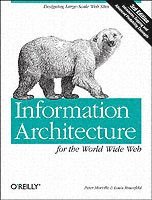
- Format
- Häftad (Paperback)
- Språk
- Engelska
- Antal sidor
- 504
- Utgivningsdatum
- 2006-12-01
- Upplaga
- 3 Rev ed
- Förlag
- O'REILLY & ASSOCIATES
- Illustratör/Fotograf
- Illustrations
- Illustrationer
- Illustrations
- Dimensioner
- 233 x 177 x 20 mm
- Vikt
- Antal komponenter
- 1
- ISBN
- 9780596527341
- 760 g
Information Architecture for the World Wide Web 3rd Edition
Designing Large-scale Web Sites
Slutsåld
Kundrecensioner
Fler böcker av författarna
-
Information Architecture, 4e
Louis Rosenfeld, Peter Morville, Jorge Arango
-
Ambient Findability
Peter Morville
-
Search Patterns
Peter Morville, Jeffery Callender
-
Information Architecture
Louis Rosenfeld, Peter Morville, Jorge Arango
Övrig information
Peter Morville is president of Semantic Studios, an information architecture, user experience, and findability consultancy. For over a decade, he has advised such clients as AT&T, IBM, Microsoft, Harvard Business School, Internet2, Procter & Gamble, Vanguard, and Yahoo. Peter is best known as a founding father of information architecture, having co-authored the field's best-selling book, Information Architecture for the World Wide Web. Peter serves on the faculty at the University of Michigan's School of Information and on the advisory board of the Information Architecture Institute. He delivers keynotes and seminars at international events, and his work has been featured in major publications including Business Week, The Economist, Fortune, and The Wall Street Journal. You can contact Peter Morville by email (morville@semanticstudios.com). You can also find him offline at 42.2 N 83.4 W or online at Lou Rosenfeld is an independent information architecture consultant. He has been instrumental in helping establish the field of information architecture, and in articulating the role and value of librarianship within the field. Lou played a leading role in organizing and programming the first three information architecture conferences (both ASIS&T Summits and IA 2000). He also presents and moderates at such venues as CHI, COMDEX, Intranets, and the web design conferences produced by Miller Freeman, C|net and Thunder Lizard. He teaches tutorials as part of the Nielsen Norman Group User Experience Conference.
Innehållsförteckning
- Chapter 1: Defining Information Architecture
- Chapter 2: Practicing Information Architecture
- Chapter 3: User Needs and Behaviors
- Chapter 4: The Anatomy of an Information Architecture
- Chapter 5: Organization Systems
- Chapter 6: Labeling Systems
- Chapter 7: Navigation Systems
- Chapter 8: Search Systems
- Chapter 9: Thesauri, Controlled Vocabularies, and Metadata
- Chapter 10: Research
- Chapter 11: Strategy
- Chapter 12: Design and Documentation
- Chapter 13: Education
- Chapter 14: Ethics
- Chapter 15: Building an Information Architecture Team
- Chapter 16: Tools and Software
- Chapter 17: Making the Case for Information Architecture
- Chapter 18: Business Strategy
- Chapter 19: Information Architecture for the Enterprise
- Chapter 20: MSWeb: An Enterprise Intranet
- Chapter 21: evolt.org: An Online Community
- Appendix 1: Essential Resources
